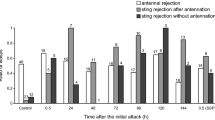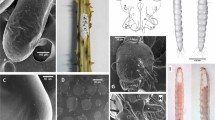Abstract
CONSIDERABLE diversity of opinion has been expressed regarding the stage in which hibernation of the ‘blow fly’, Lucilia sericata Meigen, takes place. Records are given variously as: (a) Mainly in the pupal, but also in the larval stage.1 (b) Both in pupal and larval.2 (c) In the larval stage.3
Similar content being viewed by others
References
Graham-Smith, G. S., Parasitol, 8, 4, 440–544; 1916.
Kisluik, M., Ohio Jl. Sci., 17, 8, 285–294; 1917.
Davies, W. M., NATURE, 123, 759–760; 1929.
Altson, A. M., Proc. Zool. Soc. Lond., 15, 195–243; 1920.
Author information
Authors and Affiliations
Rights and permissions
About this article
Cite this article
HOLDAWAY, F., EVANS, A. Parasitism a Stimulus to Pupation: Alysia manducator in Relation to the Host Lucilia sericata. Nature 125, 598–599 (1930). https://doi.org/10.1038/125598a0
Issue Date:
DOI: https://doi.org/10.1038/125598a0
- Springer Nature Limited
This article is cited by
-
Parasitic and predatory behavior of Alysia manducator (Hymenoptera: Braconidae) on blow fly larvae feeding on an adult pig carcass in the Western Cape Province of South Africa: preliminary observations and forensic implications
International Journal of Legal Medicine (2024)
-
Use of parasite regulation of host endocrinology to enhance the potential of biological control
Entomophaga (1986)
-
Wechselseitige Beeinflussung des Entwicklungsablaufs bei entomophagen Parasiten und deren Wirten, erörtert am Beispiel vonColeophora-Arten(Lep., Coleophoridae) undUrophora-Arten(Dipt., Trypetidae)
Anzeiger für Schädlingskunde (1967)





